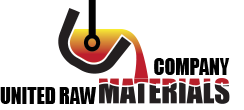Production technology
IRON & STEEL INDUSTRY
Among the variety of structural materials there are some essential that offer the most important physical and technical properties meeting the economic requirements and featuring the widest applicability. Steel being paramount of such materials satisfies the above requirements to the best extent. This explains the exceptional role of steel in development of productive power and in creation of material basis for the mankind. From the 1870s steel becomes the basic structural material for the entire industrial production. Most of the forecasts for the worldwide industrial development retain the significance of steel. However, there are also alternative standpoints that assume probable substitution of steel with non-ferrous metals, plastics and composites. Nevertheless, main forecasts for development of basic structural materials show no impact of materials interchangeability on the volumes of steel production, i.e. steel shall remain the basic structural material of the mankind in future.
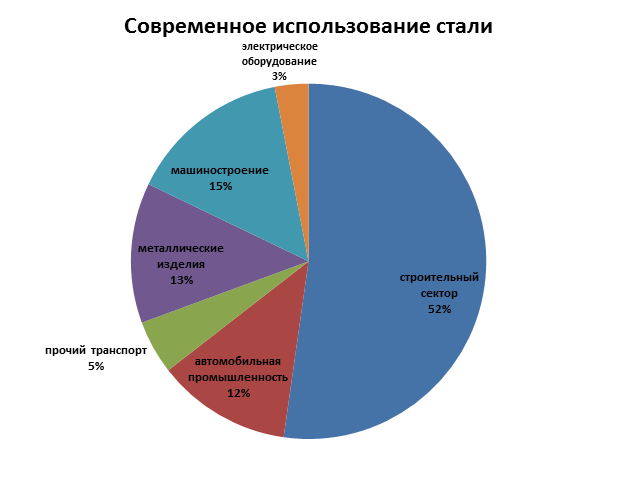
Steel is an alloy of iron and carbon where carbon content is less than 2.14%.
The contemporary and the most common steelmaking practice is the two-stage process.
- Iron making in blast furnace (iron saturated with over 2,14% of carbon)
- Iron treatment with oxygen resulting in finished steel.
It is a known fact that iron is contained in the crust is an oxidized state, mainly in form of iron minerals, hematite Fe2O3 or magnetite Fe2O3*FeO.
The main, most ancient and most common way of iron oxide decomposition is the blast furnace iron process, when iron ore chemically reacts with coke carbon:
FexOy+C=Fe+CO2
Such deoxidizing reaction requires special blast furnaces and pre-treatment of coke made from binding coal. The product of this process is pig iron that contains iron and over 2,14% of carbon.
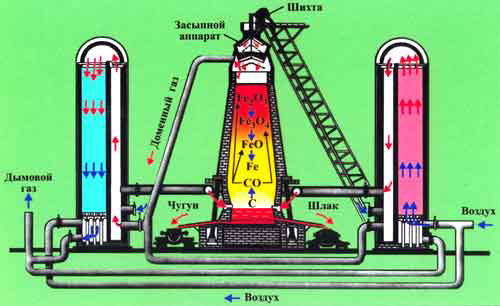
Considering that the reaction produces CO2, all raw materials for the process shall be mandatorily lumped. This is necessary to allow all produced gases easily go through the charged materials. Ore lumping mainly utilizes two processes: sintering and pelletizing.
Pig iron made in a blast furnace is iron saturated with carbon. Such product is brittle due to high carbon content which makes it impractical for fabrication of important metal details. Obtaining good properties of such iron requires extraction of carbon, i.e. decarburizing. Molten pig iron is blown with oxygen in special metallurgical devices – oxygen converters. Steel production requires 80-85% of molten pig iron and 15-20% of scrap metal.
This process is used for production of 70% of steel in the world.
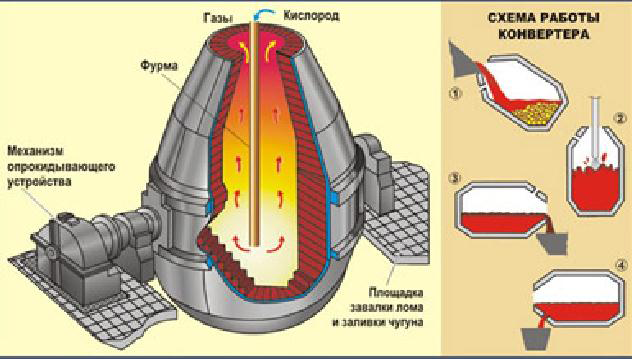
Conversion of accumulated scrap metal into steel is normally made in electric arc furnaces that are used for production of 30% of steel in the world.
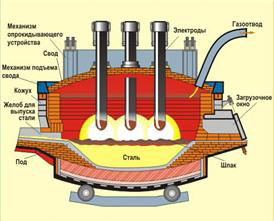
In the 20th century the world’s steel production output increased from 28 million ton up to 800 million ton. In the first decade of the 21st century the world’s steel output was almost doubled and reached 1.490 million ton in 2011.
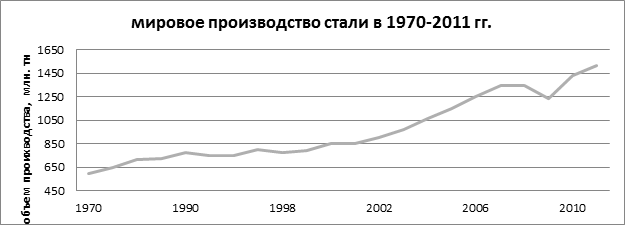
Steel consumption per head in some countries of the world, kg/man
| Country | 2008 | 2009 | 2010 | 2011 |
|---|---|---|---|---|
| Europe (27) | 372 | 243 | 294 | 310 |
| Turkey | 283 | 234 | 302 | 341 |
| Russia | 251 | 178 | 255 | 292 |
| Ukraine | 149 | 83 | 117 | 143 |
| Canada | 441 | 284 | 417 | 416 |
| USA | 323 | 192 | 257 | 284 |
| Brazil | 122 | 93 | 129 | 123 |
| Iran | 225 | 258 | 291 | 284 |
| China | 336 | 412 | 436 | 459 |
| Japan | 612 | 415 | 500 | 506 |
| Korea | 1210 | 936 | 1077 | 1156 |
| World, total | 196 | 181 | 205 | 214 |
Steel production by process type:
| Country | Total steel production, mln. ton | Oxygen converter, %% | Electric arc furnace, %% | Open hearth furnace , %% |
|---|---|---|---|---|
| Europe (27) | 177,2 | 56,7 | 42,8 | 0,5 |
| CIS | 113,5 | 64,2 | 20,9 | 14,9 |
| North America | 117,5 | 39,9 | 60,1 | |
| Central and South America | 49,3 | 62,3 | 36,6 | 0 |
| Africa | 15,6 | 32 | 68 | 0 |
| Middle East | 20,8 | 11,1 | 88,9 | 0 |
| Asia | 974,9 | 79,8 | 20,1 | 0,0 |
| TOTAL | 1514,1 | 69,5 | 29,2 | 1,2 |
Major countries and companies producing steel in 2011
| Place | Country | million ton |
|---|---|---|
| 1 | China | 683,9 |
| 2 | Japan | 107,6 |
| 3 | USA | 86,4 |
| 4 | India | 71,3 |
| 5 | Russia | 68,9 |
| 6 | Korea | 68,5 |
| 7 | Germany | 44,3 |
| 8 | Ukraine | 35,3 |
| 9 | Brazil | 35,2 |
| 10 | Turkey | 34,1 |
| 11 | Italy | 28,7 |
| 12 | Taiwan, China | 22,9 |
| 13 | Mexico | 18,1 |
| 14 | France | 15,8 |
| 15 | Spain | 15,5 |
| 16 | Iran | 13,2 |
| 17 | Canada | 13,0 |
| 18 | United Kingdom | 9,5 |
| 19 | Poland | 8,8 |
| 20 | Belgium | 8,0 |
| 21 | South Africa | 7,5 |
| 22 | Austria | 7,5 |
| 23 | Netherlands | 6,9 |
| 24 | Egypt | 6,5 |
| 25 | Australia | 6,4 |
| 26 | Malaysia | 6,0 |
| 27 | Argentina | 5,6 |
| 28 | Czech Republic | 5,6 |
| 29 | Saudi Arabia | 5,3 |
| 30 | Sweden | 4,9 |
| 31 | Other | 66,6 |
| TOTAL | 1517,8 |
Crude steel production (million ton )
| место | Company | Tons |
|---|---|---|
| 1 | ArcelorMittal | 97,2 |
| 2 | Hebei Group | 44,4 |
| 3 | Baosteel Group | 44,3 |
| 4 | POSCO | 39,1 |
| 5 | Wuhan Group | 37,7 |
| 6 | Nippon Steel | 33,4 |
| 7 | Shagang Group | 31,9 |
| 8 | Shougang Group | 30,0 |
| 9 | JFE | 29,9 |
| 10 | Ansteel Group | 29,8 |
| 11 | Shandong Group | 24,0 |
| 12 | Tata Steel | 23,8 |
| 13 | United States Steel | 22,0 |
| 14 | Gerdau | 20,5 |
| 15 | Nucor | 19,9 |
| 16 | ThyssenKrupp | 17,9 |
| 17 | Evraz | 16,8 |
| 18 | Maanshan | 16,7 |
| 19 | Benxi | 16,5 |
| 20 | Hyundai Steel | 16,3 |
| 21 | RIVA Group | 16,1 |
| 22 | Valin Group | 15,9 |
| 23 | Severstal | 15,3 |
| 24 | Metinvest | 14,4 |
| 25 | China Steel Corporation | 14,0 |
| 26 | SAIL | 13,5 |
| 27 | Sumitomo Metal | 12,7 |
| 28 | IMIDRO | 12,6 |
| 29 | Jainlong Group | 12,4 |
| 30 | MMK | 12,2 |
| 31 | NLMK | 12,1 |
| 32 | Rizhao | 11,2 |
Raw materials and supplies
Original raw materials and supplies for iron and steel industry are iron ore, coal, scrap metal and ferroalloys.
Iron ore: World’s annual mining of iron ore comprises about 1.8 billion ton where over half of the production belongs to three countries, China (18%), Brazil (20%) and Australia (24%). Other major production countries are India (12%) and CIS (11%). Mining of iron ore in these countries grows rapidly. Brazil and Australia are the major ore suppliers making about 60% of the world exports. Many countries of the world, including those where iron ore is mined, i.e. USA, UK, Italy, China, etc. import steel. Major importing countries are Japan, Germany and Korea. Despite of certain structural changes in the industry, smelters remain the basic type of iron and steel enterprises in the majority of the developed economies. Full cycle of iron and steel production is characterized by high consumption of materials with respect to the weight of final product.
Coal: Coal is mined in 70 countries of the world. However, only 4 companies control the world coal trading: Xstrata, Rio Tinto, BMA and Anglo American. The growing 13% (720 mln ton) of the total world coal mining is used in iron and steel industry supporting about 70% of global steel production (in blast furnace process). Requirements to quality of these coals are very high and specific while many countries do not have appropriate coal deposits or they have mined them out. This is why the rate of deficiency of these coals in the world market is getting higher. Today, the carbonization coal takes about 25% in the world coal trading being the most growing and the most volatile segment in the coal market. Since there is no official statistical data, Australian bureau of agriculture, resources and economy (ABARE) made approximate evaluations showing that the scope of the metallurgical coal world trading was increased by 17% up to 259 mln. ton in 2010-2011 as compared to 2009.
Smelting of 1 ton of iron consumes about 1.5 – 1.65 tons of iron ore (the more iron is contained in the ore, the less is its consumption). Same process requires up to 0.85 tons of carbonization coal and 4-5 tons of raw materials and fuel in the whole. This is why the ideal locations for development of iron and steel industry have always been countries and areas rich of iron ore, coal and fuel. For example, India, China, Kazakhstan, Australia, Donetsk and Dnieper regions of Ukraine are notable for their combination of iron and manganese ores and carbonization coal. Somehow, such favourable combinations of natural resources are very rare, this is why many metallurgic regions and centers are established either close to iron ore mines (e.g. Lorraine in France, Great Lakes in the USA, the Alps in Italy, in Sweden and Brazil), or near the coal mines (e.g. Ruhr in Germany, Pennsylvania in the USA, Donbas in Ukraine, Kuzbas in Russia, etc.).
An additional and quite sufficient raw materials contribution for iron and steel industry is represented by metal scrap resources (old scrap, production wastes etc.). Recycling of metal scrap results in higher output of steel as compared to iron because it is more profitable (cheaper) to use scrap for making steel excluding the pig iron phase.
As many more countries collected recyclable raw materials the primary metallurgical phases (blast furnace practices) were substituted using inland or imported metal scrap. Almost half of the steel in the USA is produced not from iron but from scrap (mainly in new plants located in the West Coast and in the South). The same situation is in the other developed economies, in new industrial countries (especially in Asia) and in Russia.
In addition to old and traditional locations of iron and steel industry established in various countries either on combination of ore and coal or individually on coal, ore or metal scrap, the industry has been extensively developed also in sea shore areas, especially in the last few years. Such type of locations for iron and steel industry provides delivery of raw materials and fuel and shipping of final product by sea vessels. In many cases import of iron ore (scrap) and coal is even more profitable than operating local fields and deposits. For example, almost all plants in Japan are located at the sea shore which is very convenient for delivery of iron ore and coal by sea transport (iron ore is exported to Japan from Australia, India and Brazil while coal is supplied from Australia and China). Big metallurgic plants are created in port cities of Italy (Napoli, Genoa, Taranto), France (Marcel, Dunkirk), USA (Baltimore, Philadelphia), China (Wuhan), Germany, United Kingdom, Belgium, Netherlands and other countries. In all above examples, likewise in the case of Japan, metallurgic locations assume use of imported iron ore and coal. For European countries iron ore comes from Africa and South America, coal comes from the USA. The USA imports iron ore from Brazil, Venezuela and Canada.
China, Japan, USA, Russia, Germany, Korea, Brazil, United Kingdom, France and Italy are leaders in steel production of the world. Steel industry is a constituent in economies of some other countries like Australia, Canada, South Africa, Sweden, Austria, Spain, Ukraine, Poland and Benelux countries.
Developing countries are constantly raising their presence in the world’s steelmaking industry producing about 40% of steel. Primarily, these are new industrial countries like Korea, Brazil, India, Mexico, Argentina, etc.)
Steelmaking involves a great role of ferroalloys, that are used for alloying and deoxidation of steel together with removal of injurious constituents from steel.
Main ferroalloys for steelmaking are bulk ferroalloys like ferrochrome (FeCr), ferrosilicium (FeSi), manganese alloys (FeMn, SiMn). Total production rate exceeds 30 million tons.
Ferroalloys production in different countries in 2011, thousand tons
| China | India | CIS | Europe | Africa | USA | Rest of the world | TOTAL | |
|---|---|---|---|---|---|---|---|---|
| FeSi | 3900 | 68,0 | 730 | 492 | 130,0 | 170 | 710 | 6200,0 |
| SiMn | 4884 | 1213,0 | 1402 | 565 | 284,0 | 105 | 810 | 9263,0 |
| FeMn | 1703 | 431,0 | 441 | 401 | 441,0 | 6,0 | 830 | 4253,0 |
| FeCr | 2005 | 970,0 | 1451 | 365 | 3524,0 | 0 | 286 | 28316,0 |
| ИТОГО | 12492 | 2682,0 | 4024 | 1823 | 4379,0 | 281 | 2636 | 28316,0 |
Ferroalloys production utilizes manganese and chrome ores, quartzite, coke (coal) and electric power.
Average world’s consumption of ferroalloys comprises about 20 kg per 1 ton of melted steel.
Iron and steel technologies
Contemporary production scheme of ferrous metals was finalized in the early 20th century. It is represented by a three-stage process implemented in iron and steel industry this way or another.
- Pre-treatment of raw materials. Dressing of mined ore and sintering of produced materials, dressing coals and coal-to-coke conversion.
- Production of ferrous metals in blast, ferroalloy or alternative type of furnaces, solid-phase or liquid-phase metal extraction from ores.
- Primary metal processing (pig iron, metallic materials) into steel and other ferrous metal products.
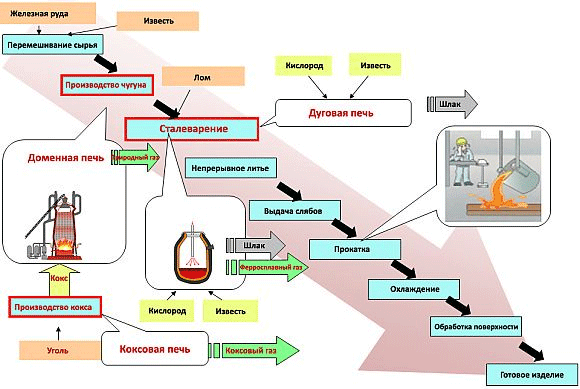
Over 90% of steelmaking is still based on iron-to-steel process. According to this process, iron fed in the charge mixture is smelted in the blast furnace and almost completely (99%) converted from charge mixture into pig iron, and then from pig iron into steel. Content of scrap metal in the process does not play any role because the scrap itself is made from pig iron.
Despite of apparent complexity the ‘iron-to-steel’ process as compared to the direct ‘ore-to-steel’ process has its undeniable advantages, i.e. possibility to make metal of any grade from any material with iron content, high power- and material efficiency, high productivity of the facilities in term of unit rates and total values.
Experience of industrial development increased and corrected the number of new processes and criteria of their production success. However, none of the suggested options for a direct ‘ore-to-steel’ process appeared to be competitive.
The principle feature of the new steel production technologies assumes that coke is substituted with gas or coal as the sources for heat and for deoxidizing. Another peculiarity of the new technologies is a tendency to use non-pelletized iron-containing materials in the charge mixture.
The new processes with hot metal as a final product can be grouped as follows:
- Combined processes where phases of pre-heating, deoxidizing and melting are separated and performed consequently in two or three interconnected devices. Examples of such processes are Corex, DIOS, AISI, CCF, etc.
- Single phase processes where all the processes are performed in one device. Examples of such processes are Romelt, Hismelt, Ausirion, Techored and others.
In general, iron and steel industry of the 21st century remains and will remain a good combination of various steelmaking technologies where the factors of resources, ecology and economy are predominant.
